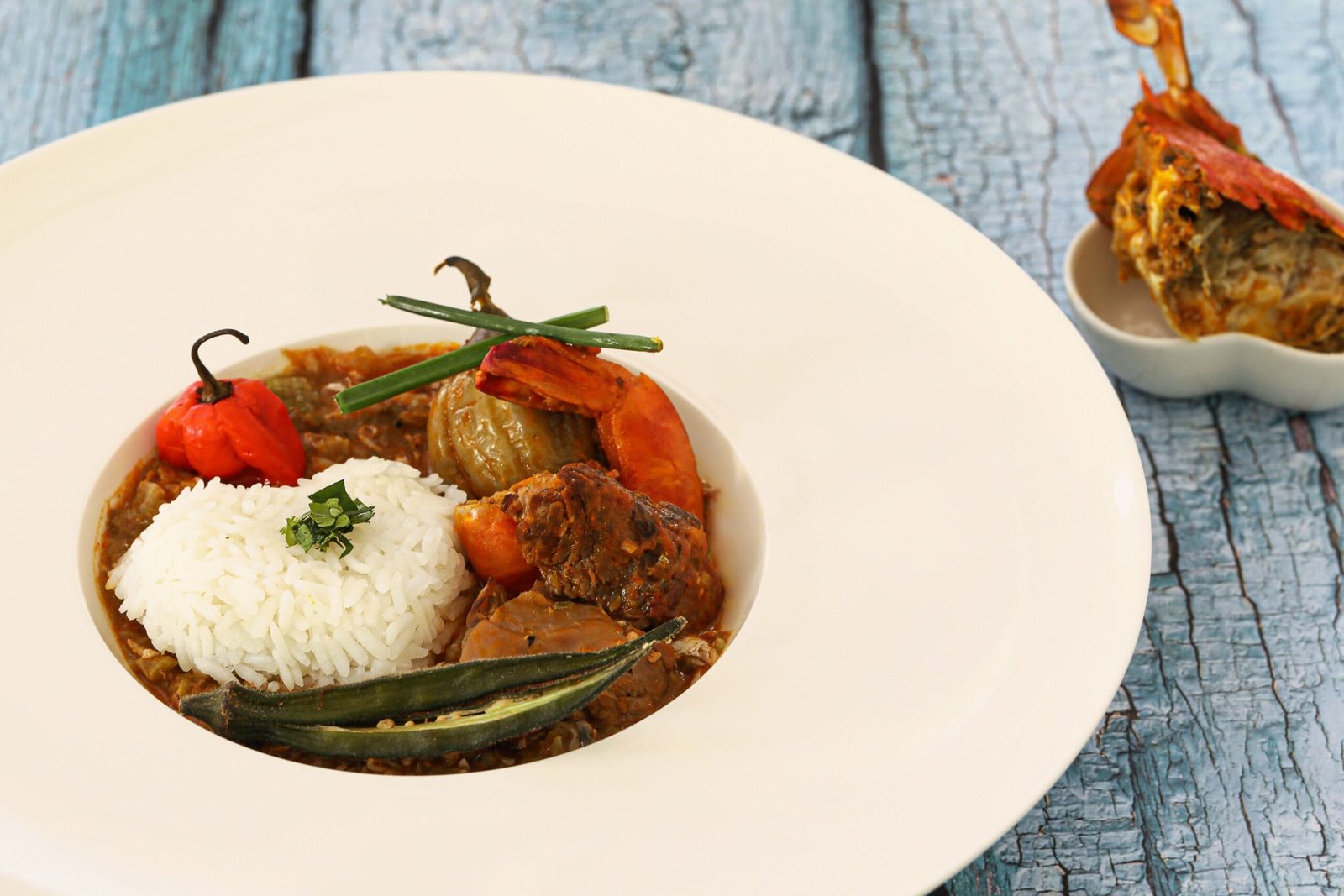
Introduction to Sudanese Cuisine
Sudanese cuisine is a rich mosaic of flavors and culinary traditions that reflects the nation’s history and cultural diversity. This cuisine draws influence from various regions and communities, resulting in a vibrant array of dishes that are as flavorful as they are diverse. When one delves into Sudanese food, it becomes evident that the meals are often centered around wholesome, natural ingredients such as grains, vegetables, and pulses, with a notable emphasis on legumes and spices that are integral to the cooking process.
A cornerstone of Sudanese cooking is the use of stews, which serve as a comforting and hearty meal option. Stews in Sudan are not merely a form of sustenance; they represent a communal aspect of dining, often enjoyed in family gatherings and social celebrations. Common ingredients found in these stews include a variety of meats—such as chicken, lamb, or beef—and a plethora of vegetables. One of the most cherished ingredients in these stews is the okra, which adds both texture and flavor, enhancing the overall culinary experience.
The significance of stews in Sudanese cuisine can also be attributed to their versatility. They can be adapted to cater to different tastes, dietary restrictions, and seasonal availability of ingredients. This adaptability allows cooks to create unique culinary expressions that resonate with their individual experiences and the traditions of their communities. Furthermore, stews are often accompanied by staple foods like rice, sorghum, or flatbreads, which help balance the dish and create a fulfilling dining experience. The importance of these meals extends beyond mere nutrition, as they embody the hospitality and warmth characteristic of Sudanese culture.
What is Okra Stew?
Okra stew is a traditional dish that highlights the unique flavors and culinary practices of Sudanese cuisine. At its core, the stew features okra, a green vegetable known for its distinctive texture and flavor, which serves as the primary ingredient. The dish is often enriched with meat, typically lamb or beef, which adds depth and heartiness to the meal. Additionally, ripe tomatoes play a vital role, introducing a tangy sweetness that balances the various components of the stew.
The preparation of okra stew reflects a blend of tradition and home-cooked comfort. The typical method involves sautéing diced meat until tender, followed by the addition of chopped tomatoes, which are simmered to create a rich sauce. Fresh or frozen okra is then incorporated, allowing it to cook through while maintaining its unique characteristics. Spices such as garlic, onion, and chili peppers can also be included to enhance the flavor profile. This combination of ingredients results in a nourishing dish steeped in flavor and cultural significance.
In Sudanese households, okra stew is more than just food; it is a staple meal that carries a sense of togetherness and family. It is usually served with a side of rice or flatbread, which acts as a perfect accompaniment, allowing diners to scoop up the hearty stew. This dish is particularly popular during gatherings and celebrations, illustrating its importance in social and cultural settings. Overall, okra stew not only embodies the essence of Sudanese flavors but also serves as a comforting reminder of home-cooked meals shared among loved ones.
Nutritional Benefits of Okra
Okra, known for its distinctive texture and unique flavor, is a vegetable that provides numerous health benefits, making it a valuable ingredient in dishes like Sudanese okra stew. One of the most notable attributes of okra is its high fiber content. This fiber plays a crucial role in digestive health, helping to regulate bowel movements and prevent constipation. Incorporating okra into one’s diet can thus enhance digestive efficiency, promoting overall gut health.
In addition to being a good source of dietary fiber, okra is rich in various vitamins and minerals. It contains significant amounts of vitamins A and C, both of which are vital for maintaining healthy skin and a robust immune system. Vitamin A is known for its role in vision and skin health, while vitamin C acts as a powerful antioxidant, protecting cells from damage and aiding in collagen production. Furthermore, the presence of vitamin K in okra contributes to bone health by playing a role in bone formation and helping with calcium absorption.
Antioxidants are another beneficial component found in okra. These compounds help combat oxidative stress in the body by neutralizing harmful free radicals. The presence of antioxidants is essential in reducing the risk of chronic diseases such as heart disease and cancer. By including okra in meals, individuals can boost their intake of these protective substances, supporting a more resilient immune system and overall well-being.
When preparing Sudanese okra stew, the inclusion of this vegetable not only enhances the dish’s flavor but also significantly contributes to a nutritious diet. The combination of fiber, vitamins, and antioxidants found in okra makes it an excellent choice for those looking to improve their health through balanced food options.
Choosing the Right Meat for Your Stew
When preparing a traditional Sudanese okra stew, selecting the appropriate type of meat is crucial as it significantly influences the flavor and texture of the final dish. Commonly used meats include beef, lamb, and chicken, each offering distinct characteristics that enhance the umami profile of the stew. Understanding the nuances of these meats can help ensure a delicious outcome.
Beef is a popular choice for its robust flavor and the ability to withstand slow cooking, allowing it to become tender while infusing the stew with deep, savory richness. Cuts such as chuck or brisket are ideal due to their marbling, which adds moisture and flavor. When cooking beef in okra stew, it is advisable to sear the meat first, locking in juices before simmering it with the vegetables and spices. This technique results in a hearty stew that is sure to satisfy.
Lamb, particularly when using shoulder cuts, also brings a unique flavor to okra stew. Its slightly gamey taste complements the earthy tones of the okra and spices beautifully. Lamb benefits from similar cooking methods to beef; however, it generally requires less time to achieve the desired tenderness. Care should be taken not to overcook lamb, as it can become dry, detracting from the overall quality of the food.
Chicken represents a lighter option in the stew, offering a more delicate flavor profile. Whole chicken or boneless thighs are often preferred due to their tenderness and moisture retention. The cooking method can differ slightly, with chicken usually requiring a shorter cooking time. It is common to add the chicken later in the simmering process to prevent it from becoming too soft, thus allowing it to maintain some structure while absorbing the delicious flavors of the stew.
By carefully selecting your meat and employing appropriate cooking techniques, you can create an exquisite Sudanese okra stew that showcases the rich flavors and satisfying textures of the ingredients used.
Ingredients List for Sudanese Okra Stew
The richness of Sudanese Okra Stew can largely be attributed to the carefully selected ingredients used in its preparation. At the heart of this dish is fresh okra, a vegetable prized not only for its unique texture but also for its ability to enhance the stew’s overall flavor profile. When choosing okra, look for bright, vibrant pods that are tender and free from blemishes. The freshness of the okra will significantly influence the stew’s taste and texture.
Next, various spices play an essential role in defining the character of the stew. Commonly used spices include ground coriander, cumin, and occasionally a dash of chili powder for those who prefer a bit of heat. These spices should ideally be sourced whole and ground fresh, as this process releases their natural oils and intensifies their flavors, resulting in a more aromatic dish.
Meat is another fundamental ingredient in traditional Sudanese Okra Stew. Lamb or beef is often preferred, as it contributes a rich, savory taste that complements the freshness of the vegetables. For those opting for a lighter version, chicken can also be used; it provides a different texture while still pairing well with the other ingredients. Selecting high-quality, organic meats will undoubtedly elevate the dish.
Additionally, other vegetables such as tomatoes, onions, and garlic offer depth and complexity to the stew. Fresh tomatoes add acidity, which balances the richness of the meat, while onions and garlic infuse a savory undertone that is indispensable. Always choose ripe and aromatic vegetables for the best results. To source these ingredients, consider visiting local farmers’ markets where you can find seasonal produce that aligns with the essence of Sudanese cooking.
Step-by-Step Preparation Guide
To prepare a delectable Sudanese Okra Stew, one must begin by gathering the essential ingredients. This dish typically includes fresh okra, tomatoes, onions, garlic, and an assortment of spices such as cumin and coriander. Additionally, consider including a protein source like chicken or beef, if desired. The first step involves washing and trimming the okra, which allows it to maintain a vibrant texture during cooking.
Next, finely chop the onions and garlic. Sauté these two ingredients in a large pot with a tablespoon of oil over medium heat. It is crucial to cook them until they become translucent, as this step enhances the overall flavor profile of the stew by releasing their aromatic properties. Once the onions and garlic are ready, add the chopped tomatoes and allow this mixture to simmer until it breaks down into a thick sauce, approximately 10 minutes.
At this juncture, it is essential to introduce the spices, stirring them into the tomato base. This step is particularly beneficial as it helps to awaken their distinct aromas, which are critical to an authentic Sudanese experience. If including meat, add it now, ensuring it is well-coated in the spiced tomato mixture. Allow it to brown slightly before adding water to create a more stew-like consistency.
Finally, incorporate the okra and bring the entire mixture to a gentle boil. Then, reduce the heat to low, cover the pot, and let it simmer for about 30 minutes. Monitoring the stew is important; stirring occasionally will prevent the okra from sticking to the bottom and encourages even cooking. A gentle simmer helps maintain the okra’s shape while allowing all the flavors to meld beautifully. Once finished, taste the stew to adjust the seasoning if necessary before serving. This method ensures a richly flavored dish that is sure to satisfy any palate, be it novice or seasoned cook alike.
Serving Suggestions and Pairings
Sudanese Okra Stew is a rich and flavorful dish that is often enjoyed for its unique blend of spices and tender okra. To enhance this culinary experience, it is essential to consider suitable accompaniments that complement the stew’s robust flavors. Traditionally, this hearty dish is served with a side of rice, which acts as a perfect canvas for soaking up the savory sauce. Fluffy white rice, seasoned with a touch of salt or spices such as cumin, pairs exceptionally well, allowing diners to savor the full depth of the stew.
For those looking for a different texture and flavor, serving the stew with flatbreads, such as fufu or pita, can elevate the meal. These breads not only provide a delightful contrast to the savory okra and meat but also serve as an excellent vehicle for scooping the stew, creating an interactive dining experience. Additionally, including a refreshing side salad featuring fresh vegetables and herbs can offer a vibrant counterpoint to the warmth of the stew. A simple mix of tomatoes, cucumbers, and a squeeze of lemon juice can brighten flavors while adding a nutritious element to the meal.
When it comes to drink pairings, selecting beverages that can balance the meal is crucial. A light and crisp drink, such as a sparkling water with lemon, can cleanse the palate effectively between bites. For those who prefer alcoholic options, a medium-bodied white wine may enhance the dining experience, while a chilled lager provides a refreshing contrast to the hearty stew. Alternatively, a traditional Sudanese drink, such as hibiscus tea, can be an excellent choice, offering a sweet and tart flavor that pairs well with the umami elements of the stew. Thoughtful pairings enhance the overall enjoyment of the meal, making each bite memorable.
Cultural Significance of Okra Stew in Sudan
Okra stew, known locally as “bamya,” holds a profound cultural significance in Sudanese society, representing hospitality, comfort, and community. This dish is not merely food but a symbol of togetherness, tradition, and belonging. Within Sudanese households, okra stew frequently graces the dining table during family gatherings and celebrations, embodying the spirit of sharing meals and bonding with loved ones. It is a common sight during festive occasions, where families come together to enjoy the rich flavors and nourishing qualities of this beloved dish.
For many Sudanese families, the act of preparing okra stew is steeped in ritual and heritage. Recipes are often passed down through generations, with each family adding its unique touch to the dish. These adaptations reflect the distinct regional flavors and ingredients available, showcasing the diversity of Sudanese cuisine. The preparation and consumption of okra stew is an opportunity for families to connect and preserve their culinary heritage, instilling a sense of pride in their cultural identity.
Moreover, okra stew signifies hospitality in Sudanese culture. When guests arrive, offering traditional dishes such as this stew is a warm welcome, signifying respect and appreciation for visitors. It is common for Sudanese families to go above and beyond to ensure that their guests experience the rich tastes and aromas of their culinary traditions. In this way, okra stew serves as both sustenance and a cultural emblem, reinforcing the ideals of hospitality and community spirit.
In summary, the significance of okra stew extends beyond its nourishment; it enriches family bonds and highlights the importance of sharing meals within the Sudanese culture. Through the celebration of this dish, newer generations learn the values of togetherness and hospitality, ensuring that the cherished traditions surrounding okra stew endure through time.
Frequently Asked Questions about Okra Stew
Okra stew is a beloved dish in many cultures, including Sudanese cuisine, and frequently, individuals have questions regarding its preparation, variations, and storage methods. One common inquiry pertains to the various recipes available for this dish. Indeed, okra stew can be diverse in its ingredients and preparation techniques. While the traditional Sudanese version utilizes fresh okra, tomatoes, onions, and spices, variations may include the addition of meats, such as chicken or lamb, or even vegetarian alternatives like chickpeas. This flexibility allows individuals to tailor the stew to their personal tastes and dietary restrictions.
Storage is another area where many seek guidance. Properly storing okra stew can significantly extend its shelf-life while retaining its rich flavors. It is advisable to refrigerate the stew in an airtight container, where it can typically last for up to three days. If you plan to keep it longer, freezing is a viable option. When reheating, it is essential to do so gently to avoid overcooking the okra, which can turn it slimy. Adding a splash of water during reheating can help maintain the desired consistency.
Another frequent question involves substitutions for specific ingredients. Some individuals may not have all ingredients on hand, so substitutions can often be made without compromising the dish’s integrity. For example, if fresh okra is unavailable, frozen okra is a suitable alternative. Similarly, if certain spices are lacking, one can adjust by using similar herbs and spices that align with the flavor profile of the stew. These adaptations not only make the dish more accessible but also allow personal creativity in crafting a delicious meal.
With these insights, readers can confidently approach making okra stew, exploring its rich flavors while incorporating their unique preferences.





